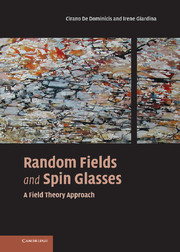Book contents
- Frontmatter
- Contents
- Preface
- List of abbreviations
- 1 A brief introduction
- 2 The Random Field Ising Model
- 3 The dynamical approach
- 4 The p = 2 spherical model
- 5 Mean field spin glasses: one-step RSB
- 6 The Sherrington–Kirkpatrick Model
- 7 Mean field via TAP equations
- 8 Spin glass above D = 6
- 9 Propagators, mostly replicon
- 10 Ward–Takahashi Identities and Goldstone modes
- 11 Alternative approaches and conclusions
- Appendix A Renormalization at one loop: ϕ4 theory (pure Ising)
- Appendix B Renormalization at one loop: tr ϕ3 theory (spin glass)
- Index
3 - The dynamical approach
Published online by Cambridge University Press: 21 October 2009
- Frontmatter
- Contents
- Preface
- List of abbreviations
- 1 A brief introduction
- 2 The Random Field Ising Model
- 3 The dynamical approach
- 4 The p = 2 spherical model
- 5 Mean field spin glasses: one-step RSB
- 6 The Sherrington–Kirkpatrick Model
- 7 Mean field via TAP equations
- 8 Spin glass above D = 6
- 9 Propagators, mostly replicon
- 10 Ward–Takahashi Identities and Goldstone modes
- 11 Alternative approaches and conclusions
- Appendix A Renormalization at one loop: ϕ4 theory (pure Ising)
- Appendix B Renormalization at one loop: tr ϕ3 theory (spin glass)
- Index
Summary
The replica trick leaves an unsatisfactory taste, on account of its unphysical character. We will now introduce an alternative, more physical approach, based on dynamics (De Dominicis, 1978). Recently, the dynamical approach has proved extremely powerful in addressing the complex behaviour of glassy systems at low temperature (see Bouchaud et al., 1998, for a review of recent results). For mean field spin glass systems the dynamics has been fully solved, revealing interesting new patterns of off-equilibrium behaviour where time translational invariance is broken and fluctuation–dissipation relations are violated. Interestingly, the theoretical framework developed for mean field systems seems to be an adequate starting point to describe a great variety of finite dimensional systems, from real spin glasses to glass forming liquids, driven granular matter, critical and coarsening systems, etc.
In this chapter, we describe the dynamical approach from a general perspective, building the formalism step by step, introducing the dynamical observables and their properties. Our starting point is the Langevin equation, that describes the relaxational dynamics of a system in contact with a thermal bath (Section 3.1). Then, for a Ginzburg–Landau–Wilson Hamiltonian, we illustrate how to perform a perturbative analysis via a tree-like expansion of the dynamical equation (Section 3.1.2), or through the more sophisticated Martin–Siggia–Rose generating functional (Section 3.2). Finally, the whole approach is generalized for the Random Field Ising Model where complications arise due to the presence of the quenched disorder.
- Type
- Chapter
- Information
- Random Fields and Spin GlassesA Field Theory Approach, pp. 35 - 56Publisher: Cambridge University PressPrint publication year: 2006

